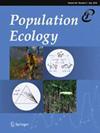Dispersal by gray ratsnakes: Effects of sex, age and time
IF 1.1
4区 环境科学与生态学
Q4 ECOLOGY
引用次数: 3
Abstract
Funding information University of Illinois; World Wildlife Fund; Ontario Ministry of Natural Resources; Parks Canada; Natural Sciences and Engineering Research Council of Canada Abstract Dispersal is one of the most fundamental components of ecology. Dispersal is also particularly relevant in an era of unprecedented habitat loss and climate change. We used a unique dataset to examine dispersal in gray ratsnakes (Pantherophis spiloides). Over a decade, we marked and released >1,500 hatchlings while monitoring the population of ratsnakes over a large area (≈1,900 ha). We tested the hypotheses that dispersal should be (a) largely restricted to within the local population given previous genetic evidence of limited gene flow at greater distances and (b) male biased because male gray ratsnakes are under strong sexual selection. We recaptured 69 gray ratsnakes that had been marked as hatchlings after periods ranging from 1 day to 11 years. We found that dispersal distance increased with time, but was not significantly sexbiased, and that gray ratsnakes are extremely faithful to their communal hibernacula (only 2.8% of 497 juvenile and adult ratsnakes captured at least twice at communal hibernacula changed sites between years). Thus, dispersal is largely limited to the period from hatching until an individual joins a communal hibernaculum. Based on the spatial patterns of dispersal we observed, the most plausible explanation for dispersal is that hatchling ratsnakes disperse from their natal site to join a neighboring communal hibernaculum. Our study yielded the most reliable data on dispersal distances from birth by a snake to date.灰鼠蛇传播:性别、年龄和时间的影响
资助信息伊利诺伊大学;世界野生动物基金会;安大略省自然资源部;加拿大公园;加拿大自然科学与工程研究委员会摘要分散是生态学最基本的组成部分之一。在一个前所未有的栖息地丧失和气候变化的时代,分散也特别重要。我们使用了一个独特的数据集来检查灰鼠蛇(Panthophis spiloides)的扩散情况。十多年来,我们在大面积(≈1900公顷)监测鼠蛇种群的同时,标记并放生了1500多只幼鼠。我们检验了以下假设:(a)鉴于先前的遗传证据表明基因在更远的距离内流动有限,传播应在很大程度上限制在当地种群内;(b)由于雄性灰鼠蛇受到强烈的性选择,因此存在雄性偏见。我们重新捕获了69条灰鼠蛇,这些灰鼠蛇在1天至11年后被标记为孵化期。我们发现,传播距离随着时间的推移而增加,但没有显著的性别偏见,灰鼠蛇对它们的公共冬眠场所非常忠诚(497只幼年和成年鼠蛇中,只有2.8%在公共冬眠场所至少捕获过两次)。因此,传播在很大程度上局限于从孵化到个体进入公共冬眠期。根据我们观察到的扩散空间模式,对扩散最合理的解释是,刚孵化的鼠蛇从出生地扩散到附近的公共冬眠场所。我们的研究得出了迄今为止关于蛇从出生到传播距离的最可靠数据。
本文章由计算机程序翻译,如有差异,请以英文原文为准。
求助全文
约1分钟内获得全文
求助全文
来源期刊

Population Ecology
环境科学-生态学
CiteScore
3.90
自引率
11.80%
发文量
41
审稿时长
18-36 weeks
期刊介绍:
Population Ecology, formerly known as Researches on Population Ecology launched in Dec 1952, is the official journal of the Society of Population Ecology. Population Ecology publishes original research articles and reviews (including invited reviews) on various aspects of population ecology, from the individual to the community level. Among the specific fields included are population dynamics and distribution, evolutionary ecology, ecological genetics, theoretical models, conservation biology, agroecosystem studies, and bioresource management. Manuscripts should contain new results of empirical and/or theoretical investigations concerning facts, patterns, processes, mechanisms or concepts of population ecology; those purely descriptive in nature are not suitable for this journal. All manuscripts are reviewed anonymously by two or more referees, and the final editorial decision is made by the Chief Editor or an Associate Editor based on the referees'' evaluations.
 求助内容:
求助内容: 应助结果提醒方式:
应助结果提醒方式:


